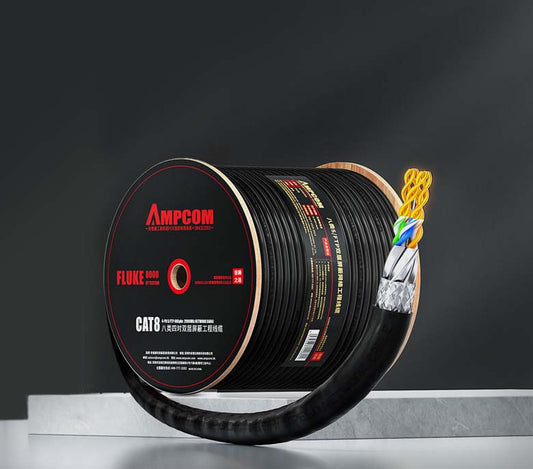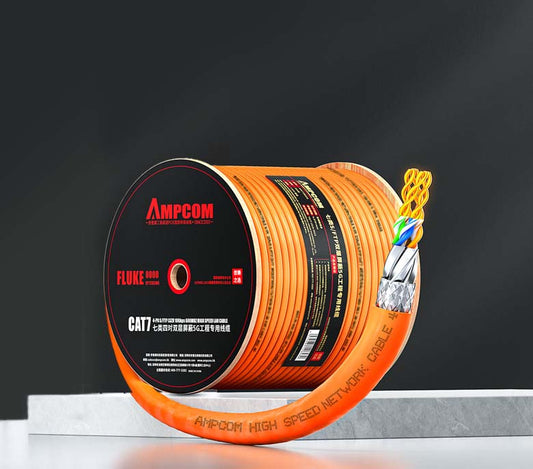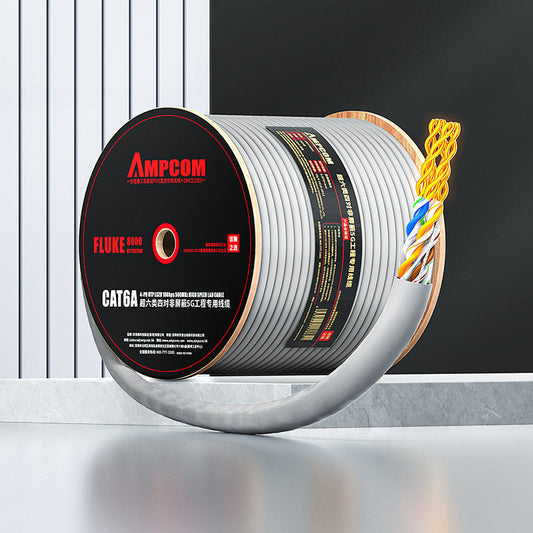CCA vs Solid Copper: Safety, Performance & Compliance Risks
Tempted by cheaper CCA Ethernet? Before you buy, understand how copper-clad aluminum behaves under PoE, why it often fails 10G targets, and where it runs afoul of code and certifications. This buyer’s guide compares CCA vs solid copper across performance, safety, compliance, and total cost of ownership so you avoid brownouts, device reboots, and failed inspections.
Last updated:
TL;DR
- Performance: CCA has ~40–60% higher DC resistance than solid copper. Expect more attenuation, higher heat rise under PoE, and shorter stable distances for 2.5/5/10G.
- Safety & code: Solid copper is the expected conductor for CM/CMR/CMP communications cables in North America. CCA commonly fails to meet listing and may violate local code when used in risers or plenums.
- PoE risk: Higher voltage drop on CCA causes camera/AP reboots and flicker, especially with PoE+/PoE++ loads and warm bundles.
-
TCO: Up-front savings evaporate via truck rolls, device failures, and re-cabling. For business-critical links, solid copper wins.

What Is CCA and How Is It Marketed?
CCA (copper-clad aluminum) conductors use an aluminum core with a thin copper skin. Sellers often label these as Cat5e/Cat6 “Ethernet” to hit low price points. By contrast, solid copper uses oxygen-free or high-purity copper conductors throughout, as assumed by structured cabling standards and certification tools.
On paper, a CCA “Cat6” might cite bandwidth claims, but the physics remain: aluminum’s resistivity is higher than copper. That raises loop resistance, increases insertion loss, and amplifies voltage drop under Power over Ethernet.
Electrical Reality: Resistance, Attenuation, and 10G Margin
| Property | Solid Copper (23–24 AWG) | CCA (Advertised same AWG) | Impact in the field |
|---|---|---|---|
| Conductor resistivity | Low (copper) | Higher (aluminum core) | More attenuation and voltage drop on CCA |
| DC loop resistance | Baseline per TIA for category | ~40–60% higher than copper | Reduced PoE headroom; device brownouts |
| Temperature rise in bundles (PoE) | Lower | Higher | Accelerated aging; channel derating needed |
| 10GBASE-T reach | Cat6a: 100 m typical | Often fails above short-to-mid runs | Flaky links; fallback to 1G/2.5G |
Note: Exact values vary by construction, plating thickness, twist geometry, and test temperature.
Quick PoE voltage-drop example
Consider a 100 m horizontal link with PoE++ (IEEE 802.3bt Type 4) delivering up to 0.96 A per pair set. A representative solid-copper loop may drop roughly 4–5 V over 100 m. A comparable CCA loop, at ~60% higher resistance, can exceed 7–8 V drop. Devices with tight power margins (PTZ cameras, Wi-Fi 6/6E/7 APs, panel PCs) may reboot or throttle, especially in warm bundles.
PoE, Heat, and Bundle Effects
Aluminum’s higher resistance means more I²R heating during PoE. In dense trays, that heat accumulates, raising conductor temperature, which further increases resistance and loss. With CCA, this spiral narrows the operating window:
- Lower delivered voltage at the PD (powered device), risking brownouts.
- Reduced noise margin at higher PHY rates (2.5G/5G/10G).
- Greater derating need: shorter maximum channel length, fewer cables per bundle, active cooling requirements.
If you must power high-draw endpoints or run long channels, solid copper conductors (preferably 23 AWG for Cat6a) preserve voltage and preserve PHY stability.
Safety, Listings, and Code Compliance
Communications cable listings such as CM, CMR (riser), and CMP (plenum) in North America are evaluated to stringent flammability and construction requirements. Solid copper conductors are the norm assumed by product standards and inspection practice. CCA constructions frequently lack compliant third-party listings or misuse print legends, creating risk of:
- Failed inspections in riser or plenum spaces.
- Voided warranties on active hardware or cabling systems.
- Liability exposure if a fire event involves non-listed cabling.
Always verify the exact listing mark (e.g., UL, ETL), the rating (CM/CMR/CMP), and file number against the certifier’s database. If a cable is described as “network cable” without a clear listing or uses ambiguous terms like “CCA Cat6,” treat it as non-compliant for commercial installations.
Certification Pitfalls and Warranty Surprises
Most field testers, certification programs, and vendor system warranties are designed around copper conductors. With CCA:
- Permanent link/channel certification may fail DC resistance, insertion loss, and balance metrics.
- Even if day-one passes, seasonal temperature swings and PoE heating can push marginal CCA channels over the edge.
- Many switch/AP vendors disclaim support if cabling deviates from TIA/ISO expectations.
Total Cost of Ownership: Why Cheap Cables Become Expensive
CCA typically saves a few dollars per drop up front. But add one truck roll for a rebooting camera, a failed AHJ inspection, or a re-pull for 10G, and the project’s cost advantage evaporates. Solid copper simplifies future upgrades, supports higher PoE classes, and holds certification across seasons—crucial for lifecycle ROI.
How to Identify CCA and Avoid Counterfeits
Practical checks to separate solid copper from CCA before you deploy:
- Spec sheet honesty: Look for explicit “solid bare copper” language and conductor gauge (e.g., 23 AWG solid). If it says “CCA,” “aluminum,” or avoids stating the metal, assume CCA.
- Listing verification: Confirm UL/ETL file numbers and ratings (CM/CMR/CMP) on the certifier’s website.
- Weight and feel: Copper is denser; a 305 m box of real copper weighs noticeably more than CCA equivalents.
- DC loop resistance: Field testers can measure loop resistance. Values significantly above TIA baselines indicate CCA or undersized conductors.
- Magnet tests and scraping: Not definitive or recommended for acceptance. Rely on documentation and measurable electrical parameters.
Is There Any Valid Use for CCA Ethernet?
For structured cabling in commercial buildings, education, healthcare, and data centers, use solid copper exclusively. CCA might appear in low-risk hobby or short, non-PoE patching, but even there it adds fragility. If the link matters to uptime or safety, choose copper.
Buyer’s Checklist
- Specify solid bare copper conductors for Cat5e/Cat6/Cat6a.
- Match flame rating to pathway: CM for general, CMR for risers, CMP for plenums.
- Verify third-party listing (UL/ETL) and file number.
- Require field certification results for representative links.
- For PoE++ and 10G, prefer Cat6a 23 AWG, manage bundle counts, and keep pathways cool.
For background on metallurgy and signal loss, see Copper Purity and Network Performance. For sourcing tips, visit Comprehensive Purchasing Guide. To model lifecycle cost, read Network Cables TCO Strategy.
FAQs
Is CCA really Cat6 or Cat5e compliant?
Category performance targets assume copper conductors. CCA frequently fails DC resistance and insertion-loss margins needed for full-reach Cat5e/Cat6, especially under PoE or higher ambient temperatures.
Can I run PoE/PoE+/PoE++ over CCA?
It may power on, but voltage drop and heat rise dramatically increase with CCA. Expect flicker, reboots, or early failures—particularly in long, warm, or dense bundles.
Is CCA Ethernet cable UL listed for riser or plenum?
Communications riser (CMR) and plenum (CMP) listings are based on constructions that presume copper conductors. Many CCA products lack legitimate listings and risk failing inspection.
How can I quickly tell if a cable is CCA?
Read the datasheet and jacket print for “solid bare copper.” Validate listing numbers. Check box weight and measure loop resistance with a tester. If the metal is unstated, assume CCA.
Does CCA save money in the long run?
Not for business networks. Any initial savings are easily offset by truck rolls, downtime, failed 10G upgrades, and replacement costs. Solid copper protects uptime and future-proofs paths.
Next Steps
Standardize on solid copper for all structured cabling. For PoE-dense or 10G environments, choose Cat6a 23 AWG, validate listings, and certify representative links. Your future self—and your uptime—will thank you.



